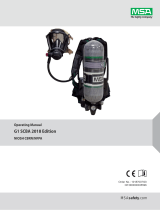Page is loading ...

Printed in U.S.A
©Copyright Air Systems International, Inc. 2000. All Rights Reserved.
AIR SYSTEMS INTERNATIONAL, INC.
829 Juniper Crescent, Chesapeake, Va. , 23320
Telephone (757) 424-3967
Toll Free 1-800-866-8100
Fax No. (757) 424-5348
http://www.airsystems.cc
e-mail: [email protected]
Operating Manual
Model MP-2300ENB
MULTI-PAK
TM
BOTTLED AIR CART WITH
LOW PRESSURE ALARM WHISTLE
Manual No. PAK014
(Rev 1 September 2001)
Air Systems International, Inc.
Registered to ISO 9001
Certificate No. A5033

SPECIFICATIONS AND PARTS IDENTIFICATION
Size w/o cylinders:
48H x 25W x 31D
Wei
g
ht w/o c
y
linders
120 lbs.
Frame:
Steel (Powder coated)
Cylinder Straps:
Four (4) adjustable
Whip Assemblies:
5000psi (345 bar) rated 4:1 safety factor
Bleeder Valves
Allows depressurization of hand tight nut
Check Valves:
Allows independent cylinder operation
Low Pressure
Whi stl e:
Pneumatic - set at approximately 500psi
(34.5 bar)
Regulator:
0-5500psi (379bar) inlet
0-125psi (8.6 bar) discharge
Regulator Flow
Rate:
80 cfm @ 100psi discharge
Relief Valve:
125psi (8.6 bar) ASME preset
Ai r Distributi on:
Four (4) quick connect fittings
Intrinsically Safe:
No electronic devices

STEP 5)
Couple respirators and lengths of
hoses to the manifold and readjust
pressure regulator if necessary. The
system is now operational.
STEP 3)
Open one cylinder. At this time the low pressure
warning alarm will sound until it sets itself at
approx. 1000psi (69 bar). Check reading on
gauge to verify cylinder is full. Close the
cylinder.
STEP 4) LOW PRESSURE
ALARM TEST
Set the required respirator pressure
with the regulator control knob and
bleed the pressure at either the re-
lief valve or by partially engaging a
male plug into one of the respirator
couplings. This depressurizes the
manifold and simulates low cylin-
der pressure. The low pressure
warning alarm will sound at ap-
proximately 500psi (35bar). Open
the other cylinder. Check reading
on gauge to verify cylinder is full.
STEP 1)
Install cylinders on MULTI-
PAK
TM
tray. Secure cylinders
by tightening the straps at the
buckle and mate the velcro sec-
tions to prevent slipping.
STEP 2)
Install universal CGA-347 hand
tight nuts to the cylinder valves
and tighten. Insure both bleeder
valves are closed by turning
fully clockwise.
SETUP PROCEDURE
OPERATION
When the cylinder in use has been depleted to approximately 500psi (35 bar), the low pressure warning alarm will
sound indicating that the cylinder needs to be replaced.
To change a cylinder while the MULTI-PAK
TM
is still in use:
1) Open the second cylinder and note the gauge pressure to assure that it is full.
2) Close the drained cylinder.
3) Open the bleeder valve to relieve line pressure. Remove the CGA-347 hand-tight nut.
4) Remove the drained cylinder and install a full cylinder in its place. Reinstall the CGA connections.
Close bleeder valves. The cylinder is now ready for use when the other cylinder’s pressure descends to 500psi.
Note: The system is equipped with check valves that will prevent back flow from the other cylinder in use.

SHUTDOWN
Make sure all personnel have egressed the hazardous area and have disconnected from the breathing air
system.
1) Close cylinder valves.
2) Depressurize manifold pressure by pulling the relief valve ring.
3) Close the regulator by turning the control knob counterclockwise.
4) Disconnect airline hoses and reinstall dust caps.
5) Remove connections from cylinders and reinstall cylinder valve covers (if applicable).
HIGH PRESSURE AIRLINE GENERAL MAINTENANCE & INSPECTION
Monthly
1. Check regulators, gauges, and valves for external leakage.
2. Inspect cylinder valves for proper closure.
3. Check cylinder pigtails for cleanliness, flexibility, wear, leakage, blisters on hose, thread damage, and
O-rings on CGA fittings. Replace damaged items immediately.
Annually
1. Check relief valve's pressure setting.
2. Check regulator function by opening and closing regulator valve knob fully.
Every 4 years
1. Replace all flexible pigtails - consult factory.
Warranty Disclaimer
Air Systems’ manufactured equipment is warranted to the original user against defects in workmanship or materials under
normal use for one year after date of purchase. Any part which is determined by Air Systems to be defective in material
or workmanship will be, as the exclusive remedy, repaired or replaced at Air Systems’ option. This warranty does not
apply to electrical systems or electronic components. Electrical parts are warranted, to the original user, for 90 days from
the date of sale. During the warranty period, electrical components will be repaired or replaced at Air Systems’ option.
NO OTHER WARRANTY, EXPRESSED OR IMPLIED, AS TO DESCRIPTION, QUALITY, MERCHANT-
ABILITY, FITNESS FOR A PARTICULAR PURPOSE, OR ANY OTHER MATTER IS GIVEN BY AIR
SYSTEMS IN CONNECTION HEREWITH. UNDER NO CIRCUMSTANCES SHALL THE SELLER BE
LIABLE FOR LOSS OF PROFITS, ANY OTHER DIRECT OR INDIRECT COSTS, EXPENSES, LOSSES
OR DAMAGES ARISING OUT OF DEFECTS IN, OR FAILURE OF THE PRODUCT OR ANY PART
THEREOF.
The purchaser shall be solely responsible for compliance with all applicable Federal, State and Local OSHA and/or MSHA
requirements. Although Air Systems International believes that its products, if operated and maintained as shipped from
the factory and in accordance with our “operations manual”, conform to OSHA and/or MSHA requirements, there are no
implied or expressed warranties of such compliance extending beyond the limited warranty described herein. Product
designs and specifications are subject to change without notice. Rev 2 12/98
Air leaks are not covered under warranty except when they result from a defective system component, i.e. an on/
off valve or regulator or upon initial delivery due to poor workmanship. Air leaks due to poor delivery or damage
will be covered under delivery claims. Minor air leaks are part of routine service and maintenance and are the
responsibility of the customer just as are filters and oil changes.
Note: When the components are used in accordance with the manufacturer's instructions and recommendations, the "system" meets or exceeds federal regulations presently in force.
It is incumbent upon the user to comply with any changes in the regulations or law which may occur in future situations.
/







